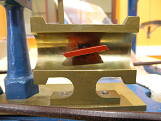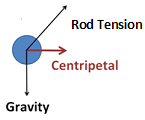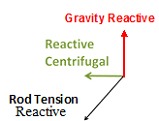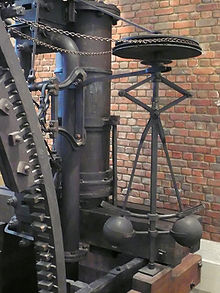WHAT TO DO
- Turn the handle at a constant speed. You are acting as an engine!
- Then, increase the speed suddenly.
What changes do you see when you increase the speed suddenly?
 |
Pay attention to the throttle valve |
Answer: The rotating masses move to a larger radius, and the throttle valve closes partially.
WHY: The centrifugal governor is an application of Newton’s 3rd law.
Newton’s 3rd law: For every action there is an equal and opposite reaction.

Think of swirling a stone at the end of a string. The string exerts the centripetal force, keeping the stone in its circular motion. This is the action. The equal and opposite reaction to that is reactive centrifugal force of the string on your hand.

In the centrifugal governor, the horizontal centripetal force on each spinning ball is the sum of the downward force of gravity and the tension from the rod supporting the ball. This centripetal force keeps the balls in motion around the center post.

From Newton’s 3rd law, we know that there is a reaction force for each of these forces, with equal size but pushing in the opposite direction. Since the rods are not fixed at one angle, the reactive centrifugal force pulls the balls outward from the center post with a higher rotational velocity. This also changes the positions of the rods, which are connected to a lever controlling the throttle valve.

Centrifugal governors have been used since the 17th century, when they were used to regulate the distance and pressure between millstones in windmills. In a steam engine, it regulates the speed of the engine by controlling the flow of steam to it. If the speed of the engine increases, the rotating masses will swing out to a larger radius and trigger a cut in the throttle thus decreasing the flow of steam to the engine and keeping the speed of the engine constant. In snowmobiles and ATVs, it can vary the transmission’s pulley diameter ratio in relation to the engine rotations per minute.
Original 1918 Museum Exhibit, Updated